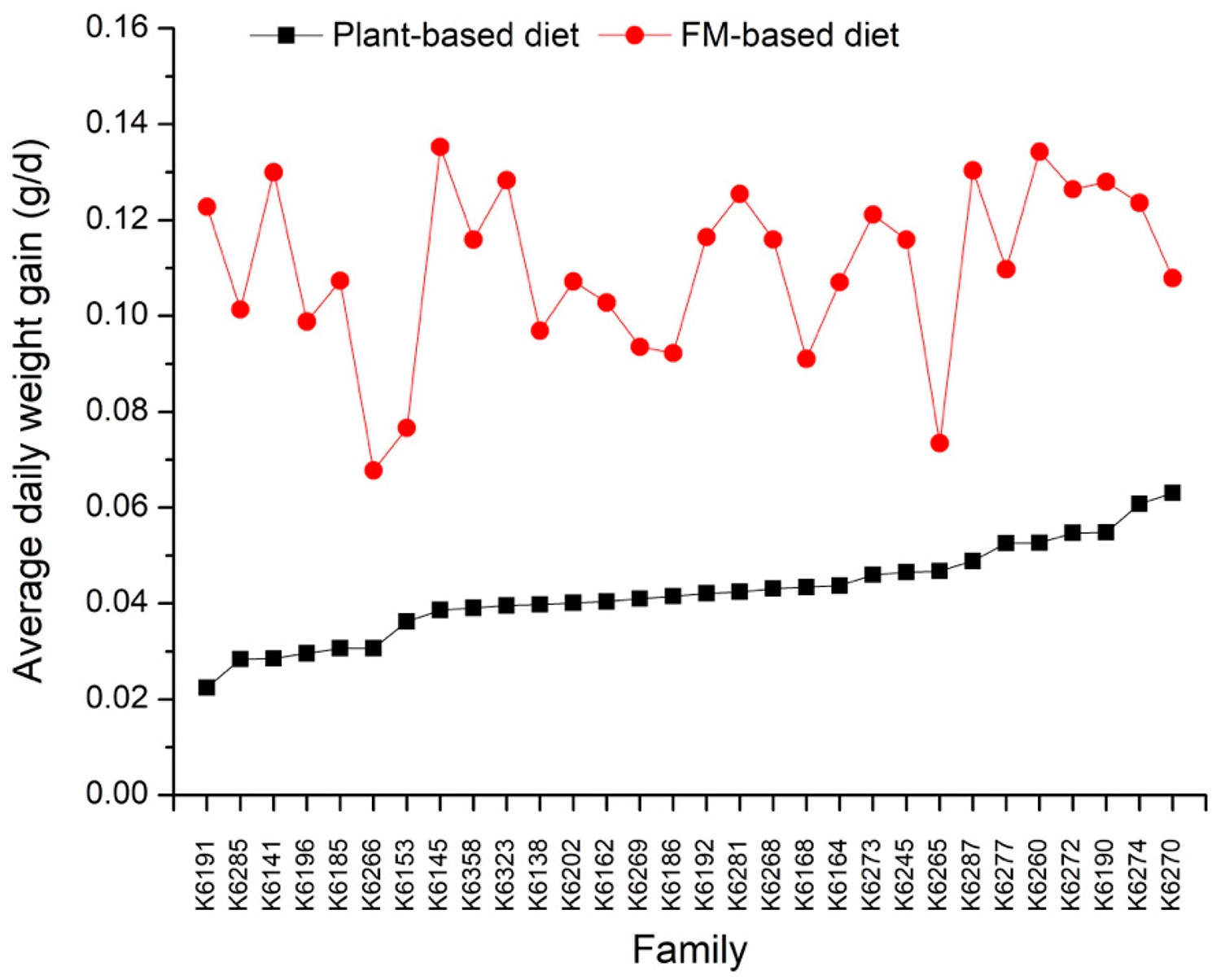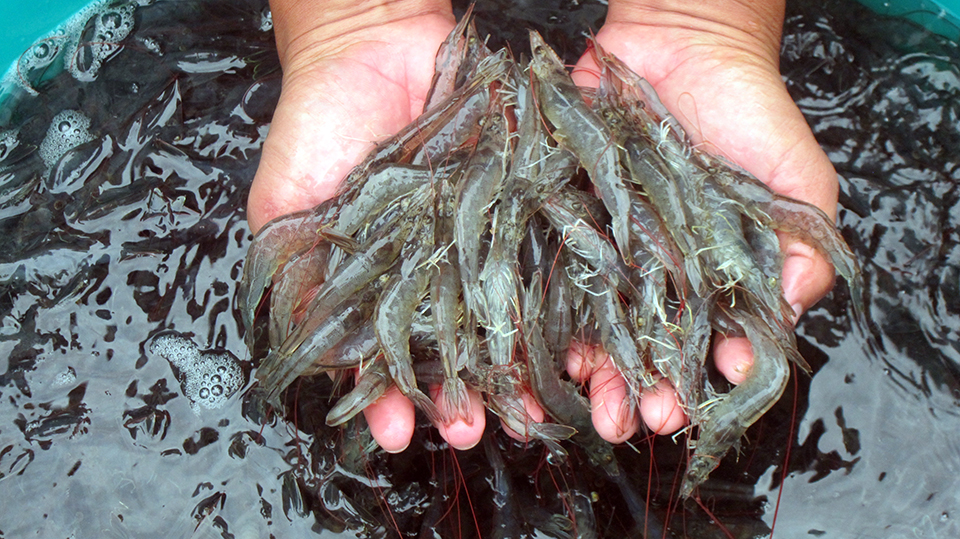Several P. vannamei families exhibited comparable or better feed efficiency under a plant-based diet

A key factor in selective breeding for feed efficiency (FE) is determining which traits to include in the selection index. Since any genetic changes observed in ratio traits such as feed efficiency ratio (FER) and feed conversion ratio (FCR) cannot be directly attributed to the genetic variation in growth or feed intake, or their combination, selecting animals based solely on FER or FCR will result in poor selection response.
Residual feed intake (RFI), defined as the difference between the actual amount of feed consumed and the expected feed consumption estimated by a regression model which considers the feed requirements for maintenance and growth as independent variables, is considered a better measure of FE. A negative RFI means an animal consumes less feed than expected, while a positive RFI indicates higher feed intake. Animals with low RFI are more efficient, and those with high RFI are less efficient. RFI has been widely used in the study of feed efficiency in livestock and poultry.
Research on RFI in aquatic animals is still relatively limited, with most focusing on fish, including African catfish, rainbow trout, and Nile tilapia. Additionally, there have been a few reports on RFI in Pacific white shrimp (Penaeus vannamei), oriental river prawn (Macrobrachium nipponense) and Pacific abalone (Haliotis discus hannai).
Genetic improvement of FE traits is crucial for selecting shrimp strains that perform well on a plant-based diet. Dai et al. reported high heritability estimates for FE traits, including FER and RFI, in P. vannamei when fed a FM-based diet. However, limited information is available about the FE of P. vannamei fed a plant-based diet, especially whether it has the potential for selective breeding. In addition, it remains uncertain whether there is a genotype-by-diet (genotype × diet) interaction effect for FE between plant-based and FM-based diets. The future use of plant-based diets could impact breeding programs if genotype × diet interaction occurs.
This article – summarized from the original publication (Dai, P. et al. 2024. Quantitative Genetics of Feed-Efficiency-Related Traits for the Pacific Whiteleg Shrimp Penaeus vannamei in a Plant-Based Diet Environment. Biology 2024, 13(12), 1012) – reports on a study to explore how the utilization of a plant-based diet impacts the genetic improvement of FE in P. vannamei.
Study setup
Thirty full-sib families of P. vannamei shrimp established in 2023, including four maternal half-sib families, were selected for this research. All the shrimp reproduction and culture were carried out at the shrimp breeding center of BLUP Aquabreed Co. Ltd. in Weifang, Shandong Province, China.
The study compared a plant-based (fishmeal-free) diet with a 25 percent fishmeal diet for Pacific white shrimp to determine whether the feed efficiency-related traits, including residual feed intake (RFI), average daily weight gain (ADG), and daily feed intake (DFI), exhibit diet-specific genetic variations and genotype-by-diet (genotype × diet) interactions.
During the 42-day feeding trial, all animals were first acclimated for one week and fed the fishmeal-based diet. The amount of diet per meal was carefully controlled to ensure consumption within half an hour. Any unconsumed pellet diet was collected in a separate container half an hour after each feeding and then dried until its weight stabilized. Eighty percent of the seawater in the tanks was exchanged daily, and the temperature was maintained at 27 ± 1 degrees-C (mean ± SD). Dead shrimp and molts were removed on a daily basis.
For detailed information on the experimental design, animal husbandry and experimental diets used, and sample and data collections and analyses, refer to the original publication.
Results and discussion
The final dataset utilized for RFI analysis consisted of 391 individuals under the plant-based diet treatment (survival rate = 86.89 percent) and 425 individuals under the fishmeal-based diet treatment (survival rate = 94.44 percent). Note that the majority of shrimp deaths in the experiment were caused by accidental jumping out of the rearing tanks.
The average RFI under the plant-based diet treatment (0.0049 g/d) was significantly higher than under the FM-based diet treatment (−0.0045 grams per day), indicating greater feed efficiency on the FM-based diet. The RFI values for 30 families under the two different diet treatments are depicted in Fig. 1, showing a range of −0.014 to 0.025 grams per day for the plant-based diet and −0.022 to 0.017 grams per day for the FM-based diet, highlighting substantial inter-family variation.

Furthermore, there were clear differences in RFI values among families between the two diets, with most families exhibiting lower utilization efficiency under the plant-based diet treatment compared to the FM-based diet treatment, but five families exhibited a utilization efficiency for the plant-based diet that was comparable to, or even better than, for the FM-based diet.
Shrimp fed the FM-based diet showed significantly higher average FBW and ADG (p < 0.001) than those fed the plant-based diet. Additionally, greater inter-individual variations in FBW and ADG were observed under the plant-based diet treatment compared to the FM-based diet treatment, as indicated by the coefficients of variation (CV). All families exhibited noticeably higher ADG under the plant-based diet treatment compared to the FM-based diet treatment (Fig. 2).

In contrast, the average DFI of shrimp between the plant-based and FM-based diets was relatively similar. The variation in DFI among families did not differ noticeably between diets (Fig. 3).

Soybean meal (SBM) and peanut meal (PM) are commonly used as plant protein sources to replace fishmeal in commercial shrimp diets in China. This study explored the feasibility of a fishmeal-free diet for P. vannamei shrimp using SBM and PM as substitutes. The fishmeal-based diet resulted in a significant growth increase of 155.8 percent, but a slight decrease in DFI by 2.8 percent compared to the plant-based diet.
Similar feed intake (FI) between diets demonstrated that shrimp readily accepted the plant-based diet, indicating no negative impact on diet palatability. Additionally, our observations revealed that shrimp fed with plant-based diet had significantly higher RFI of 0.0049 grams per day compared to the FM-based group’s −0.0045 grams per day, showing that shrimp fed with higher levels of plant protein exhibited decreased feed efficiency.
The estimated heritability values for RFI were 0.743 ± 0.157 and 0.440 ± 0.125 under the plant-based and fishmeal-based diet treatments, respectively, showing no significant difference between the two estimates. The lack of distinction in these values is primarily attributed to the larger standard errors caused by the small number of individuals within each family. These estimates align with previous heritability values (ranging from 0.580 to 0.747) derived from models without common environmental effects under a 25 percent fishmeal diet. However, when common environmental effects were accounted for, the heritability estimates ranged from 0.308 to 0.324.
The heritability estimates of ADG under the plant-based and fishmeal-based diet treatments were 0.314 ± 0.121 and 0.444 ± 0.126, respectively, which are lower than those previously reported (0.598 and 0.638) under a 25 percent fishmeal diet. The heritability estimate of DFI was very high (0.947 ± 0.158) under the plant-based diet treatment, appearing to be significantly inflated, while the fishmeal-based diet estimate (0.678 ± 0.147) aligns with previous findings (0.664 and 0.696) under a 25 percent fishmeal diet [19]. These estimates exceed reported heritability values for feed intake in fish (0.112 to 0.45). Considering the FE and growth performance of families under both diets, it is suggested that FE under plant-based diets has greater selection potential than growth. Our results also suggest that the shrimp selected for greater growth consume more feed than needed for growth.
Considering diet as an environmental factor, the genetic correlation between RFI under the plant-based and fishmeal-based diet treatments was 0.646 ± 0.162, indicating a moderate genotype × diet interaction effect. This suggests that the presence of fishmeal in the diet impacts the feed utilization efficiency of P. vannamei shrimp, with notable differences in fishmeal requirement among different genotypes. More importantly, we found that five families exhibited a utilization efficiency for plant protein feed that was not lower than that for fishmeal feed. This reflects, from another perspective, the feasibility of conducting breeding programs aimed at improving the utilization efficiency of plant-based diet.
Additionally, our data highlighted that ADG is notably influenced by the genotype × diet interaction, with a low genetic correlation of 0.296 ± 0.259 under two diet treatments. Overall, our findings suggest that the genotype × diet interaction effect on growth traits, caused by the presence of FM in the diet, is more significant than the interaction effect due to variation in fishmeal content.
Perspectives
The significantly lower feed efficiency (FE) and growth of Pacific white shrimp on the plant-based diet compared to the fishmeal-based diet suggest that a plant-based diet may lead to reduced yields, potentially affecting the profitability of shrimp culture. However, the estimated heritability of RFI under the plant-based diet reached 0.743 ± 0.157, indicating some potential for selective breeding, even though there may be an overestimation due to unaccounted-for common environmental effects.
Notably, several families exhibited comparable or better FE under the plant-based diet than under the fishmeal-based diet. Additionally, the presence of a moderate genotype × diet interaction for RFI between the plant-based and fishmeal-based diets underscores the importance of considering selective breeding for improved feed efficiency in a plant-based diet environment.
Now that you've reached the end of the article ...
… please consider supporting GSA’s mission to advance responsible seafood practices through education, advocacy and third-party assurances. The Advocate aims to document the evolution of responsible seafood practices and share the expansive knowledge of our vast network of contributors.
By becoming a Global Seafood Alliance member, you’re ensuring that all of the pre-competitive work we do through member benefits, resources and events can continue. Individual membership costs just $50 a year.
Not a GSA member? Join us.
Author
-
Dr. Xianhong Meng
Corresponding author
State Key Laboratory of Mariculture Biobreeding and Sustainable Goods, Yellow Sea Fisheries Research Institute, Chinese Academy of Fishery Science, Qingdao 266071, China; and Laboratory for Marine Fisheries Science and Food Production Processes, Qingdao Marine Science and Technology Center, Qingdao 266237, China
Tagged With
Related Posts

Health & Welfare
DNA microarrays: New face of aquaculture genetics?
DNA microarray technology involves the individual spotting or printing by a robot of up to 10,000 DNA sequences onto a microscope glass slide.

Health & Welfare
Catfish genetics and breeding
Although research on catfish genetics began in the 1960s, applications of genetic improvement in aquaculture have lagged behind other animal industries.

Health & Welfare
Genetic markers help track soy protein utilization in shrimp
Recent research by the authors discovered genetic markers for the identification of Pacific white shrimp with enhanced capability to convert soy protein in feed.

Health & Welfare
Genomic selection for resistance to White Spot Syndrome Virus in Pacific white shrimp
Genomic selection techniques show significant potential for enhancing the species’ resistance to White Spot Syndrome Virus (WSSV) infection.



